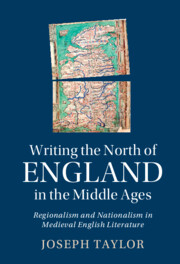 Writing the North of England in the Middle Ages
Writing the North of England in the Middle Ages Book contents
- Writing the North of England in the Middle Ages
- cambridge studies in medieval literature
- Writing the North of England in the Middle Ages
- Copyright page
- Dedication
- Contents
- Acknowledgments
- Chapter 1 Introduction: Region and Nation in England’s North–South Divide
- Chapter 2 William of Malmesbury, Bede, and the Problem of the North
- Chapter 3 The North–South Divide in the Medieval English Universities
- Chapter 4 Chaucer’s Northern Consciousness in the Reeve’s Tale
- Chapter 5 Centralization, Resistance, and the North of England in A Gest of Robyn Hode
- Chapter 6 The Towneley Plays, the Pilgrimage of Grace, and Northern Messianism
- Chapter 7 Conclusion: A Medieval and Modern North–South Divide
- Notes
- Works Cited
- Index
- Cambridge Studies in Medieval Literature
Chapter 5 - Centralization, Resistance, and the North of England in A Gest of Robyn Hode
Published online by Cambridge University Press: 08 December 2022
- Writing the North of England in the Middle Ages
- cambridge studies in medieval literature
- Writing the North of England in the Middle Ages
- Copyright page
- Dedication
- Contents
- Acknowledgments
- Chapter 1 Introduction: Region and Nation in England’s North–South Divide
- Chapter 2 William of Malmesbury, Bede, and the Problem of the North
- Chapter 3 The North–South Divide in the Medieval English Universities
- Chapter 4 Chaucer’s Northern Consciousness in the Reeve’s Tale
- Chapter 5 Centralization, Resistance, and the North of England in A Gest of Robyn Hode
- Chapter 6 The Towneley Plays, the Pilgrimage of Grace, and Northern Messianism
- Chapter 7 Conclusion: A Medieval and Modern North–South Divide
- Notes
- Works Cited
- Index
- Cambridge Studies in Medieval Literature
Summary
Chapter 5 investigates the fifteenth-century ballad A Gest of Robyn Hode as protest literature set against the encroachment of government centralization on the political autonomy of the North of England. Robin Hood’s theft and murder of government officials ironically informs the outlaw’s own expressed love for the king, calling to mind the relationships between the crown and the northern magnates, such as the Percy earls of Northumberland, in the later Middle Ages. In one striking scene from the Gest, King Edward and Robin Hood ride out of the forest together, dressed in Robin’s livery of Lincoln green. This juxtaposition of the king of England with the king of outlaws implies the complexities with which the poem contemplates law and sovereignty, complexities attendant to the remarkable development of sovereign theory from the early-thirteenth century in western Europe. Foregrounding the exceptional powers of the sovereign that would inform the political theory resonate in the later work of Bodin and Hobbes, the Gest laments the dwindling regional autonomy of the North, with its once-great barons, and the increasing pull of law and authority to London and Westminster.
- Type
- Chapter
- Information
- Writing the North of England in the Middle AgesRegionalism and Nationalism in Medieval English Literature, pp. 113 - 136Publisher: Cambridge University PressPrint publication year: 2022


